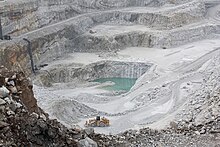
Back جير Arabic Əhəng Azerbaijani Эзбиз (материал) Bashkir Koich BAR Kalkē BAT-SMG Вапна Byelorussian চুন (খনিজ) Bengali/Bangla Calç Catalan Kalk Danish Baukalk German

Lime is an inorganic material composed primarily of calcium oxides and hydroxides, usually calcium oxide and/or calcium hydroxide. It is also the name for calcium oxide which occurs as a product of coal-seam fires and in altered limestone xenoliths in volcanic ejecta.[1] The International Mineralogical Association recognizes lime as a mineral with the chemical formula of CaO.[2] The word lime originates with its earliest use as building mortar and has the sense of sticking or adhering.[3]
These materials are still used in large quantities as building and engineering materials (including limestone products, cement, concrete, and mortar), as chemical feedstocks, and for sugar refining, among other uses. Lime industries and the use of many of the resulting products date from prehistoric times in both the Old World and the New World.[citation needed] Lime is used extensively for wastewater treatment with ferrous sulfate.
The rocks and minerals from which these materials are derived, typically limestone or chalk, are composed primarily of calcium carbonate. They may be cut, crushed, or pulverized and chemically altered. Burning (calcination) of calcium carbonate in a lime kiln above 900 °C (1,650 °F)[4] converts it into the highly caustic material burnt lime, unslaked lime or quicklime (calcium oxide) and, through subsequent addition of water, into the less caustic (but still strongly alkaline) slaked lime or hydrated lime (calcium hydroxide, Ca(OH)2), the process of which is called slaking of lime.
When the term is encountered in an agricultural context, it usually refers to agricultural lime, which today is usually crushed limestone, not a product of a lime kiln. Otherwise it most commonly means slaked lime, as the more dangerous form is usually described more specifically as quicklime or burnt lime.
- ^ "Lime in Handbook of Mineralogy" (PDF). Retrieved 24 April 2017.
- ^ Pasero, Marco; et al. (May 2022). "The New IMA List of Minerals – A Work in Progress" (PDF). The New IMA List of Minerals. IMA – CNMNC (Commission on New Minerals Nomenclature and Classification). Archived (PDF) from the original on 10 May 2022. Retrieved 7 June 2022.
- ^ "Online Etymology Dictionary". Retrieved 24 April 2017.
- ^ Kumar, Gupta Sudhir; Ramakrishnan, Anushuya; Hung, Yung-Tse (2007), Wang, Lawrence K.; Hung, Yung-Tse; Shammas, Nazih K. (eds.), "Lime Calcination", Advanced Physicochemical Treatment Technologies, Handbook of Environmental Engineering, vol. 5, Totowa, NJ: Humana Press, pp. 611–633, doi:10.1007/978-1-59745-173-4_14, ISBN 978-1-58829-860-7, retrieved 2022-07-26
© MMXXIII Rich X Search. We shall prevail. All rights reserved. Rich X Search